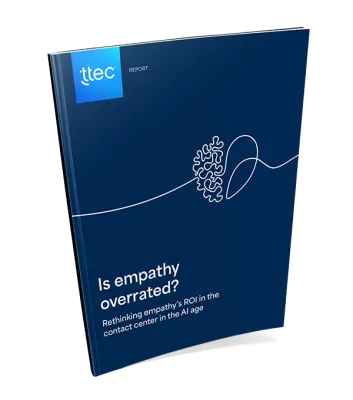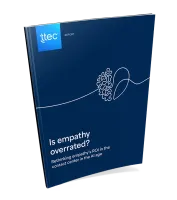AmTrust Bank, a division of NYCB Family of Banks (acquired in late 2009) and a subsidiary of New York Community Bancorp, implemented an enterprisewide strategy in recent years to provide excellence in customer service. Called ECET (Every Customer Every Time), the notion is that each client matters and every customer experience is important to bolstering and strengthening customer relationships. Whether customers are visiting a branch or speaking to a customer service rep in the call center, NYCB Family of Banks wants them to feel that the organization values their business. Here, Mark Beausoleil, director of retail sales and service, discusses the components of exceptional service and how the company ensures that the concept resonates with every employee.
We've always put the customer relationship first—that has been central to NYCB Family of Banks. Every Customer Every Time (ECET) shares the same vision. The desire was to ensure that "customer" is engrained in the organization by making service excellence a priority.
In my role as retail sales and service director for the bank, my most immediate goal was to create an experience that clients talk about. Word of mouth is the [best] advertising that we can have. There's a bank on every corner today, so the more we focus on creating a positive and memorable experience with every customer, every time, we generally can maximize how favorably clients perceive our bank. Ultimately, that's at the core of our service standards— understanding the client's perception.
Our service delivery is a disciplined methodology with many components, but the three key components of ensuring that we are delivering a strong experience include:
1. Accuracy: We consistently seek to get it right and accurate for the client each and every time. Our bankers must be good bankers first and foremost.
2. Responsiveness: We communicate and follow up in the acceptable timeframes determined by our clients. Following up builds trusted relationships.
3. Courtesy and relationship: We use positive words, tone, inflection, and empathy in all that we do. We seek to create an emotional connection with clients beyond taking care of just their day-to-day banking needs. We are caring about the long-term success of each customer and strive to build relationships strong enough to pass to the next generation.
Moving in unison
For ECET to work, we all have to be moving in unison. It's an ongoing process that comes from the top. In doing so, we're making leaders more accountable. Each leader is responsible for identifying gaps in service, determining solutions, and putting a plan in place to address them.
The leaders start by ensuring that all employees understand the vision of what we are trying to accomplish and the expectations of all employees in delivering world-class service. This also ensures that we understand the components of the delivery, that we appreciate and cherish the "lens," or perception of the customer, and that it is at the center of all we do and at all customer touchpoints.
We also make certain that employees understand that "Everything Speaks," which is a program where we ensure that we deliver personalized service, but also that our branches and locations are conducive to maximizing the clients' positive experiences. For instance, how does a messy teller station "speak" to our clients? Conversely, what does the crisp, professional appearance of our banking professionals say to our clients? We spend a great deal of time ensuring we are consistent in delivering the outward experience that we are trying to create.
Additionally, we try to teach our bankers to have a heightened sensitivity to customers' needs. This helps to create an emotional connection by being sensitive to clients' responses to their experience in the branches, learning about clients to know their preferences, and taking the time to learn about their financial needs, as well as how their personal situation affects those needs.
Our banks also strive to find a commonality with the customer, something that connects the banker to the customer beyond the financial conversation (such as shared family experiences, mutual community interests, or shared backgrounds). I want employees to become so in tune with clients that even if a client doesn't express a concern verbally they can still "read it." For instance, if a client waits longer than usual in the teller line on a busy Friday afternoon and signals dissatisfaction through their demeanor, but doesn't verbalize it, we need to pick up on that and make it right.
It would be common in many of our branches for the teller to share these experiences with the manager, for the manager to contact the customer, acknowledge the wait time, thank them for their business, and let them know on behalf of the entire branch how much they are valued. Picking up on how the client feels and acknowledging a service gap can present a great opportunity to fortify a valued relationship.
Success begins with training and hiring
There is not one employee at NYCB Family of Banks who will tell you that they don't want to deliver good service, but success starts with training and hiring. We don't hire people who aren't confident. If they can look you in the eye and smile, that's endemic of how they may treat customers. When I interview new hires, I look for that sparkle. It's not uncommon for me to ask, "Tell me about the best service that you provided to a customer," or "Tell me about a specific customer you wowed." If a candidate can't take pride in sharing how they have gone above and beyond to build, strengthen, or win a relationship, he or she may not be the right fit for our organization. If a person can't find commonality or connection with me during the interview, then that is probably not someone who will connect with clients.
Once they're hired, employees attend training. The Talent Development team has incorporated ECET not only into a one-day class, but also, in some form, into all the training. You will see service standards sprinkled throughout our orientation, throughout the onboarding process, and then in employees' position-centric training courses. The employees in training participate in role play that shows that they're comfortable and can demonstrate our service standards. They won't "graduate" from training unless they successfully demonstrate service skills within all the components.
After they graduate, it is important for employees to understand that service and its measurement is essential to all leaders throughout the organization. I, along with the regional management teams in five states, review every Mystery Shop program and provide written feedback on each one. While typical customer satisfaction surveys tell us how customers feel, our Mystery Shop program shows us how our employees are executing on the steps to ensure goodwill to our clients.
For the employees who go above and beyond (based on feedback from surveys and Mystery Shops), I send them thank-you notes with words of encouragement. For less-than-favorable feedback about employees, I provide tips and best practices to them. Our regional team works directly with the branch manager to immediately develop a plan to correct their behavior.
We also recognize our best performers—the people in the upper echelons of service. For instance, we are launching a recognition program where they will receive a World-Class Service Chocolate Bar with an opportunity for a best-in-class ticket inside from me directly. On that ticket will be some "best-in-class points" to potentially add to their quarterly sales incentives—this intersection between sales and service is critically interwoven into our retail branch culture.
Delivering a differentiated experience
As NYCB Family of Banks continues to bring new customers into our family we expect satisfaction rates to grow. It's about getting that whole customer-centric mentality engrained into who we are as an organization. Part of my role is to ensure that each of my leaders feels and understands that. In team meetings at every level, service takes a center spot on the agenda. Regional leadership not only reports on results, but also on the gaps that need to be addressed. This is especially important as banking in general evolves to meet the various regulatory changes. While clearly there will be new requirements of banks that may affect our clients, it's how we present, communicate, and execute those changes that will make all the difference.
The bank's strong service focus seems to be working. In February New York Community Bank was named by Reputation Institute's "Global Reputation Pulse 2010" as America's most reputable bank. Clearly, those polled said that they have faith and trust in the bank, its strength, and its security. That reputation comes, in part, from delivering an experience that is consistently winning, starting with every customer, every time.















